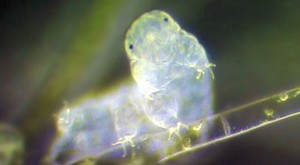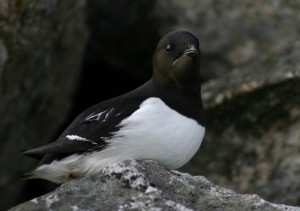Week 25 – 01 January 2017:
Seabirds Improve the Lives of… What Did You Say?
Forgive yourself if you have never heard of tardigrades; most people haven’t. Also known by the common names “water bears” and “moss piglets,” chances are very high that you are currently sitting just a few metres from members of one or more species of tardigrade. Even so, the probability that you will ever see a tardigrade is vanishingly small.
Tardigrades themselves are vanishingly small; most species are invisible with anything less than a very high quality microscope. You can’t eat them, and they can’t eat you. They don’t spread diseases, nor do they have any marketable qualities. Researchers have described about 1200 species of tardigrades, and it is entirely possible that you will never hear the word “tardigrade” ever again. But that doesn’t mean that they aren’t interesting to bird enthusiasts.
Little Auks (Alle alle) are, as their name implies, small seabirds. They eat plankton, and breed colonially in the high Arctic. They are among the most abundant seabirds in the world, and so despite their diminutive size, Little Auks have the potential to greatly modify the local environment around their colonies. As with other breeding seabirds, some of the nutrients they extract from the sea are defecated over land, changing the chemistry of the soil.
Spitsbergen Island is tucked neatly between the Arctic Ocean and the Greenland Sea, and is administered by Norway. A Polish research station has been operating at Hornsund, a fjord on southern Spitsbergen, for nearly sixty years. In 2016, Krzysztof Zawierucha of Adam Mickiewicz University in Poznań and his colleagues reported on a study of the impact of breeding Little Auks on the tardigrade community of Hornsund.
Zawierucha and his team collected moss and lichen along two transects, each a kilometre-long. One of these transects stretched from a colony of 30,000 Little Auks down to the sea. A second transect, not influenced by the Little Auk colony, acted as a control. Could it be that the enrichment of the soil downhill from the seabird colony resulted in more tardigrades? Might the species composition of the two sites be different?
Peering through their microscopes, Zawierucha and company found 1990 tardigrades from 32 different taxonomic groups with enchanting names like Isohypsibius elegans and Microhypsibius bertolaniii. Tardigrades were more abundant in the vicinity of the Little Auk colony than in the region not influenced by the seabirds, making this report the first to find a positive effect of seabird faeces on tardigrades in a polar region. Zawierucha et al. concluded that fertilization of the soil by the seabirds enhanced plant growth, which created small-scale climates that were more favorable for tardigrades.
Representatives of fifteen tardigrade taxonomic groups were found in both situations, but ten were found only along the control transect, and seven were found only along the transect leading from the Little Auk colony. Some of the differences might be attributable to small-scale differences in the environment, such as greater acidity of the soil downhill from the seabird colony. Some of the tardigrade species collected in this study had never been recorded in the region before, illustrating our lack of knowledge about many aspects of polar biology.
When I contacted Zawierucha, he explained that his main research interest was tardigrades, concerning himself with their ecology, taxonomy and biogeography, but that he was very fond of other invertebrate groups as well. He is interested in glaciers and creatures that live on glaciers as models for life that may exist on other planets. “When I saw glaciers for the first time,” he wrote, “I realised that they define rules of biodiversity and isolation.” Whether it is seabirds or miniscule animals that few people have heard of, field biologists have no end of exciting research ahead of them.
Zawierucha, K., K. Zmudczyńska-Skaarbek, Ł. Kaczmarek, and K. Wojczulanis-Jabukas. 2016. The influence of a seabird colony on the abundance and species composition of water bears (Tardigrada) in Horsund (Spitsbergen, Artic). Polar Biology 39:713-723.
Photo credits: light micrograph of a tardigrade, photograph © Sinclair Stammers – www.extremetech.com/extreme/218492-tardigrades-already-impossible-to-kill-also-have-foreign-dna; Little Auk - www.newhorizonsonline.co.uk/gallery-items/little-auk/



